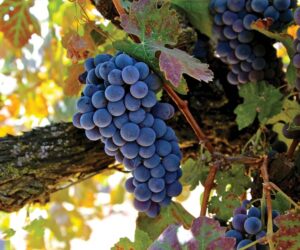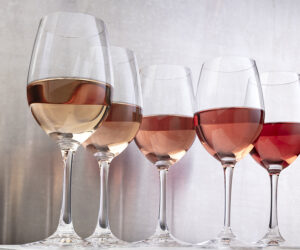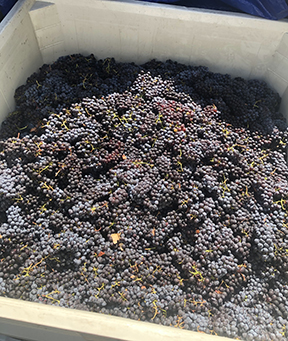
“It takes a village” is not just a cliché here in the hamlet of Los Angeles, California, but the way we prefer to share our tasks amongst our group of home winemakers. After staying at home due to the pandemic in 2020, we decided in 2021 to put together a group purchase of grapes through our home winemaking club, Cellarmasters of Los Angeles. Members of the club fulfilled the necessary roles of a negociant, driver, crusher, presser, and vigneron. Not so different from a medieval harvest!
However, this story really begins with inspiration drawn a year earlier. During the height of the pandemic our club hosted Zoom tastings with local wineries. When we tasted Angeleno Wine Company’s The Meadow Rosé, a flavorful wine made with 100% Graciano grapes, I knew immediately where those grapes had been grown, and by whom. I had carried Bokisch Vineyards wines at my wine bar, Vintura, for several years, and knew them to produce some of the most reputable Spanish-style wines in the country with grapes grown in their vineyards. I asked Amy Luftig Viste, Co-Owner of Angeleno Wine Company, if the Graciano was fruit from Bokisch in Lodi, California, which she and partner Jasper Dickson confirmed. The Cellarmasters loved The Meadow Rosé; in fact, it made such an impression that a few of us were determined to try our hands at making a similar wine.
I was excited for others to experience a love for the Graciano grape that I have long admired. Graciano is a dark, thick-skinned grape that is primarily grown in Rioja and Navarre, Spain, where it thrives in the warm and dry climate. According to the Spanish Wine Scholar textbook, Spain produces 93% of the world’s Graciano. It is rarely used to create a varietal wine — most often used as a blending component in Tempranillo or Garnacha wines because of its dark color, the acidic and tannic backbone, spicy notes, and the ability to age. It is intensely perfumed with aromas of violets, blackberry, cocoa, even a touch of menthol, with flavors of black currant and blackberry, and in certain locations a trace of black pepper. American oak is the traditional treatment in Spain, imparting flavors of vanilla and baking spice.
In 2021, Bokisch Vineyards produced almost 70 tons of Graciano out of the 7,500 tons of grapes they harvested. In 2019, according to the California Department of Food & Agriculture’s Crush Report, 795 tons of Graciano was crushed in California — nearly a 400% increase from the prior year.
The Graciano Gang
Deciding to go in on a group purchase of Graciano, the “Graciano Gang” was formed. The gang included four members: Michael Holland, President of Cellarmasters and professional scribe that imbibes; Gregg Ogorzelec, our “Knight of Whites,” saving many a muscat from a feeble life of flat flavor; Dave Lustig, our professional winemaker of 30 years and owner at Old Oak Cellars, as well as Cellarmaster’s town crier; and myself, who played negociant and cart-driver. Jasper Dickson, the winemaker at Angeleno Wine Co., was also critical in our venture having created our muse and offering his advice on our journey. Our goal was to make different styles of wine from the same bin of Graciano grapes — with each of us creating one batch of rosé, as well as a second varietal wine.
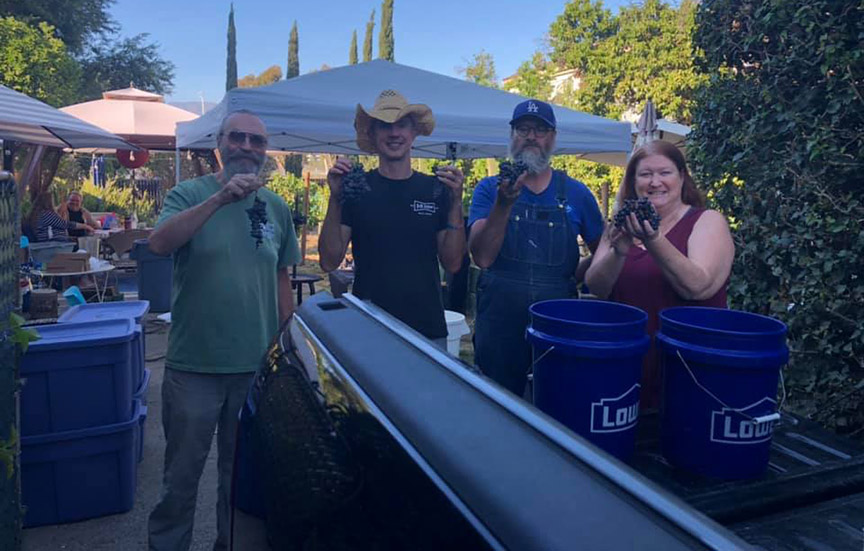
We had our village, so we took inventory of our equipment and divided tasks. Operating as negociant for the gang, I used my industry connections to purchase grapes from Bokisch Vineyards. During my years of owning a wine bar I fell in love with the value of Spanish-varietal wines, including Graciano. I purchased Garnacha, Graciano, and Tempranillo wines from Bokisch, which my guests loved. Fast forward to 2020 and the invention of Zoom wine tastings. I had participated in Bokisch’s Educational Wine Series on Zoom and afterwards had emailed Markus Bokisch to inquire about purchasing hundreds of pounds of those Graciano grapes. He agreed, and I set up a contract with Jennifer Daniel, Business Manager at Bokisch, for 1,000 lbs. (450 kg) of Graciano at $1 per pound. I started thinking about how those grapes would travel 350 miles from Lodi to SoCal.
Inching along SoCal freeways, bins secure, I felt a donkey cart would have been a faster option on that Friday afternoon than a Dodge Ram. The harvest was a night pick to give relief to the pickers and grapes, as the average September temperature in Lodi is in the high 80s to low 90s °F (low 30s °C). The 2021 harvest presented some labor issues for wineries, resulting in picking later than usual when a crew was available. The delay in picking resulted in grapes of around 25–27 °Brix, which is a bit higher than we had hoped for, but the fruit still looked tremendous. The bin of fruit was weighed, I picked up my tag, and pointed my truck toward Pasadena, California before sunrise.
Gregg Ogorzelec, who is known to experiment with weird and wonderful grapes and processes, arranged for us to use the crush pad at Villa Laural Winery, owned by Will and Debra Regan in Pasadena.
Processing the grapes
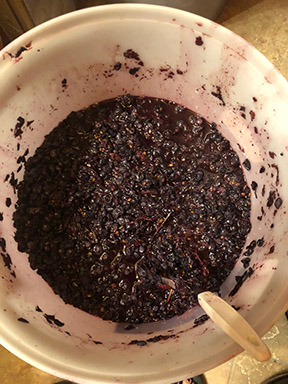
Village communications were facilitated by Dave Lustig. In his role as town crier, we were summoned to meet at 4 p.m. to begin. The discussion ensued as to how each person preferred their grapes to be processed and what style of wine was to be achieved. We were stunned at the deep purple color and questioned how The Meadow Rosé was such a beautiful pinkish-salmon color.
“The color is a surprise, even though there was only 1–2 hours of skin contact.” Gregg noted. We agreed that a traditional rosé was not possible with such dark juice.
Bucket after bucket we unloaded the deep purple, aromatic fruit from the bin and into the destemmer/crusher. Everyone had crushed their 250 lbs. (115 kg), and more discussion was had as to how much time we had to press. While darkness approached, we assembled the old Italian ratchet press with some difficulty. Michael and Dave repaired the medieval mechanism so we could start pressing out the juice for rosé. The first 100 lbs. (45 kg) were pressed by hand to the point of dry cake for my version of rosé. We discussed additives and settled on pectic enzyme to help produce a better yield, prevent pectic hazes, and produce a faster settling of the juice, as well as SO2 to protect the juice. With a laugh, we agreed that we did not need any more color extraction or aromatics!
Gregg pressed his rosé next in the dark, aware that the skin contact would create a much darker wine if left until the next day. He saved the skins and added them to the red wine must. Dave decided to take his must home to press; he collected the free-run juice within four hours, also known as the saignée method of bleeding off the juice that has been in contact with the skins for his rosé. He then added those skins to the red wine ferment for a more concentrated wine. This was a technique decided a bit on the fly, Dave admitted. “The high Brix made me reduce my rosé amount a bit (knowing that some water would be added to lower the Brix) and my red portion is a bit higher (in volume) than I was aiming for, but there are worse problems to have!”
Michael also took his must home to be pressed after 12–18 hours of skin contact the next day for his rosé and prepped his French oak barrel for his version of a fruity Graciano red wine. “Having not worked with Graciano before, the 25 °Brix benefitted the red ferment. I tend to use a new rosé ferment as a baseline; I believe in bottle aging and try to hold off drinking until year two,” remarked Michael.
From this point forward, the winemaking process was up to each individual villager.
Evaluating the Winemaking Techniques/Results
Six months later, the gang met on March 12 at Angeleno Wine Company to discuss our successes and challenges, and taste through our concoctions together. Unfortunately, Michael was not able to attend in person, but was on Zoom with us for the afternoon. We started our tasting with our muse, the 2020 The Meadow Rosé. The aromas were strawberry, cranberry, and cream with a grapefruit finish with flavors of tart cranberry, strawberry, grapefruit, and a touch of cinnamon. We asked Jasper about his recipe compared to ours; he started with whole-cluster pressing the Graciano that was at 18.35 °Brix and used indigenous yeast. The wine was racked to barrel to add texture, no MLF, no fining, no cold stabilizing, but a secret ingredient for mouthfeel. Jasper said of his winemaking style, “I am curious and playful; I respect the craft of winemaking, but love to try new things every year and explore.”
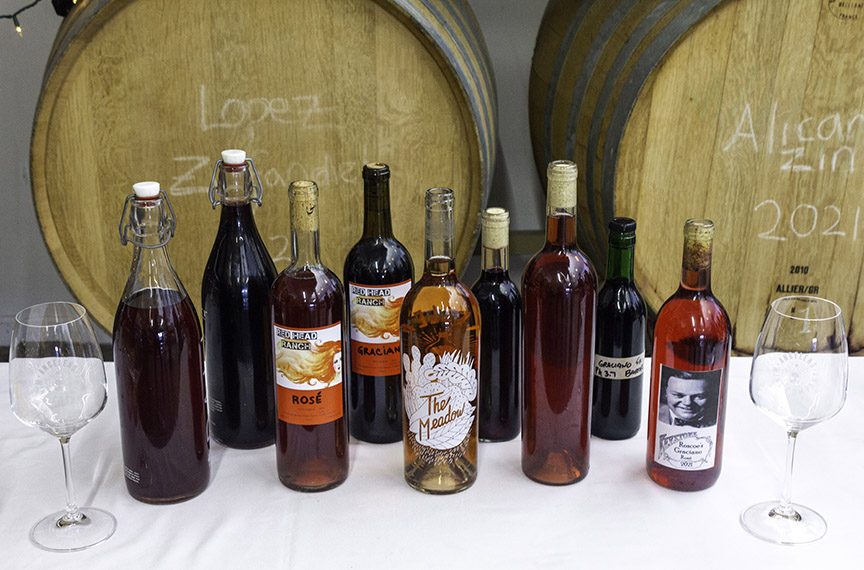
My Rookie Rosé must began at 27.5 °Brix, which was higher than ideal, and was the only problematic wine of the day. I watered back to 13.3% alcohol and added tartaric acid. I chose to let the fermentation kick off naturally, then add QA23 yeast because it will ferment at a lower temperature in my fridge fermenter. My pH went from 4.0 at crush to 3.22 at time of testing on March 10. I read about lysozyme in WineMaker magazine, and I added it to prohibit MLF in February and in March. The wine did not clear, and the consensus was to try Super-Kleer K.C. This wine was a conundrum for the group as it tested at 0.47 g/100 mL titratable acidity (TA) with final pH at 3.22, in addition to some volatile acidity (VA) at 0.65 g/L. It had a minty nose, good fruit flavors, but a chemical aftertaste. The minty nose can be attributed to the Alavesa, Rioja clone of Graciano that can present menthol and/or minty flavors. A fun fact, but not what I was going for in my rosé.
Gregg had better success with his rosé. He started at 25 °Brix with a pH of 4.0, watering back to 24 °Brix and adding tartaric acid. He chose Cross Evolution yeast for 10 days to address the high sugar in one batch, and QA23 for 16 days in another batch, which did result in a bit of a citrus finish. His rosé had the most earth, mushroom, and bramble nose and had a soft and round mouthfeel, also a trait of Cross Evolution, with black and red fruits. Gregg said he wanted to get away from the fruit-forward wine that Rhône 4600 yeast produces, so he tried two strains that were new to him.
Dave used free-run juice and he also added tartaric acid. Starting with 25 °Brix, he used QA23 yeast to produce better aromatics. The juice was at a cool fermentation for close to two weeks to retain the fruit aromas. Dave was able to use the breeze in Pasadena to bring down the fermentation temperature to 50 °F (10 °C) at night, with an average temperature of 70 °F (21 °C). The wine had a slight haze and is now in a keg under CO2. The nose expressed young red fruit and candied fruit, with flavors of cranberry and a slightly acidic finish.
Michael chose Rhône 4600 yeast for his 25 °Brix, 3.8 pH must, which resulted in exactly what the yeast promises of a rosé — strawberries! The primary flavors were red fruit and strawberries with a nice full finish. His rosé had the most skin contact, and it was evident in the candy-apple
red color.
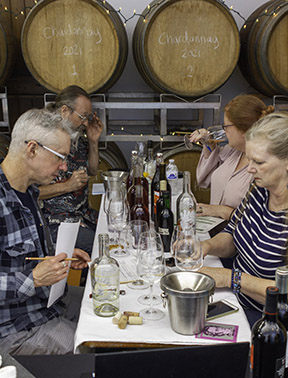
After tasting through and discussing the rosés, we moved on to the Graciano reds next. My result was a formidable 15.5% ABV table wine, which did not interfere with the dark fruit, dried fruit, and dusty tannin flavors. I used D20 yeast, created for DAOU Vineyards in Paso Robles, California, for higher-temperature ferments. This wine was the most drinkable for its age and felt like it had some of the markers of an older, aged wine. When I had this tested at Camarillo Custom Crush by Winemaker Shaun Frohn, it was hard for us to believe the numbers, but we knew we liked the taste.
Gregg and Dave added the rosé skins into the must of their red table wines and cold soaked from 2–4 days to enhance the flavor and color; they worked with the 25–27 °Brix and did not water back. Gregg added Noblesse and CLOS yeasts to add body and counter the tannins. Dave added Assmanshausen yeast to enhance the fruity flavors. Dave and I were thinking longer fermentations/macerations of 12–16 days, while Michael and Gregg had shorter fermentations of one week. Michael used the same yeast as he did with the rosé, Rhône 4600, for fruit-forward flavors. Michael’s wine is now in neutral French oak, Gregg’s wine is going into Hungarian oak for aging, while Dave’s wine didn’t touch any oak and is under gas in a keg. My wine is in glass carboys with oak staves for now.
Gregg’s wine had big red and black fruit with bramble, licorice, and a hint of sweetness. Dave had the most balanced wine for its age, with distinct Jolly Rancher aromas and young black fruits and tannin. Michael’s wine had a candied fruit nose, powerful black and red fruit flavors with tannin, and a slight meaty finish. Our wines are beginning to show markers of Graciano. It will be interesting when we judge the Cellermaster’s 49th Annual Amateur Wine Making Competition in November. Will we be able to identify Graciano in a blind tasting? The Graciano we tasted in March 2022 will have more balance by the fall but will still be very young.
Our tasting revealed that all our young wines had a Jolly Rancher/candied fruit component to them, especially the aromas. We did not get that trait from the two bottles of Bokisch Graciano we opened for comparison. The 2018, Estate Grown, Terra Alta Vineyard Graciano presented us with aromas of lavender blossom, blueberry jam, and anise. It featured flavors of black and blue fruits that enhanced the smooth, well-rounded finish, which earned it 92 points from Wine Enthusiast. And the 2018 Family Estate, Las Cerezas Vineyard Graciano had a color that is described as “dark, inky, and serious.” It had savory, meaty aromas that combined with baking spices, cedar, blueberry jam, and lavender. Flavors of dark berries, blueberry syrup, violet, and crushed earth, with a long finish that clashed against our younger wines. The age difference is three years from our wines to the Bokisch wines, so we
are very hopeful!
When asked about the winery philosophy, Markus Bokisch remarked, “Here at Bokisch, our entire approach centers around innovation. We pioneered Spanish varieties in California, being amongst the first to grow Albariño, Graciano, Verdejo, Monastrell, and many other varieties. We also are extremely non-interventionist, allowing the fruit, the terroir, and essence of each variety to express itself naturally. We like to experiment with different wood regimes that have included new, lightly toasted oak on whites, as well as Acacia barrels with Verdejos. So, perhaps ‘scientifically adventurous’ might be the best description of what we’re trying
to achieve!”
What did our merry band achieve? Most importantly, we had FUN! As Michael said, “Many hands make the work light. Spreading the work also spreads the wealth.” The project also blossomed into fundraisers, a millennial DIY workshop, and field trips to wineries. This village considers itself prosperous . . . and expanding! Our town crier announced our exploits, and we have new villagers joining the Graciano Gang, with three Bokisch Spanish varieties to occupy the hamlet for the 2022 harvest.


